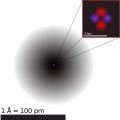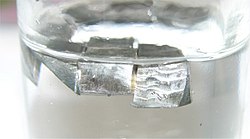trends of the atomic radii (and of various other chemical and physical properties of the elements) can be explained by the electron shell theory of the atom;...
31 KB (863 words) - 21:23, 1 September 2024
and others in 1967. The values are in picometres (pm). Atomic radii of the elements (data page) Chemical bond Covalent radius Bond length Steric hindrance...
33 KB (2,405 words) - 07:25, 24 May 2025
elements Abundances of the elements (data page) — Earth's crust, sea water, Sun and Solar System Abundance of elements in Earth's crust Atomic radii of...
3 KB (301 words) - 14:16, 17 October 2023
Van der Waals radius (redirect from Van der Waals radii)
volume" can have any number of definitions depending on the method of measurement. Atomic radii of the elements (data page) van der Waals force van der...
31 KB (2,151 words) - 10:47, 3 June 2025
Remaining elements, making up only about 2% of the universe, were largely produced by supernova nucleosynthesis. Elements with even atomic numbers are...
42 KB (4,383 words) - 02:15, 5 June 2025
Metallic bonding (redirect from Sea of electrons)
radii of the elements (data page) Bonding in solids – Classification of bondings Metal aromaticity – Concept of aromaticity extended to metals If the...
24 KB (3,401 words) - 06:56, 20 February 2025
Periodic table (redirect from The periodic table of the elements)
between the periods (except in the s-block) that is sometimes known as secondary periodicity: elements in even periods have smaller atomic radii and prefer...
252 KB (27,179 words) - 14:30, 25 May 2025
Covalent radius (redirect from Covalent radii)
30 elements in 48 crystals with subpicometer accuracy. Atomic radii of the elements (data page) Ionization energy Electron affinity Electron configuration...
15 KB (774 words) - 09:41, 16 November 2024
Atomic theory is the scientific theory that matter is composed of particles called atoms. The definition of the word "atom" has changed over the years...
78 KB (10,108 words) - 00:25, 23 May 2025
1989). "Deriving a formula for nuclear radii using the measured atomic masses of elements". American Journal of Physics. 57 (4): 344–346. Bibcode:1989AmJPh...
31 KB (3,500 words) - 21:25, 15 May 2025
Atom (redirect from Atomic chemical)
from the original on 16 October 2005. Ghosh, D.C.; Biswas, R. (2002). "Theoretical calculation of Absolute Radii of Atoms and Ions. Part 1. The Atomic Radii"...
126 KB (12,995 words) - 03:03, 2 June 2025
of the elements (data page) – ionization energies (in eV) and molar ionization energies (in kJ/mol) Atomic radii of the elements (data page) – atomic...
30 KB (3,718 words) - 00:19, 16 April 2025
Lanthanide contraction (category Atomic radius)
The lanthanide contraction is the greater-than-expected decrease in atomic radii and ionic radii of the elements in the lanthanide series, from left to...
18 KB (2,148 words) - 00:17, 25 May 2025
Rare-earth element (redirect from Rare earth elements)
rare-earth elements and decreasing atomic radii throughout the series causes chemical variations. Europium is exempt of this classification as it has two...
156 KB (16,713 words) - 18:32, 3 June 2025
Carbon (redirect from Atomic number 6)
but close to most of the nearby nonmetals, as well as some of the second- and third-row transition metals. Carbon's covalent radii are normally taken...
110 KB (12,142 words) - 05:51, 2 June 2025
Halogen (redirect from Halogen elements)
CRC Handbook of Chemistry and Physics (84th ed.). Boca Raton, FL: CRC Press. Slater, J. C. (1964). "Atomic Radii in Crystals". Journal of Chemical Physics...
52 KB (5,531 words) - 13:26, 17 May 2025
Period 2 element (redirect from Period 2 elements)
elements. The periodic table is laid out in rows to illustrate recurring (periodic) trends in the chemical behavior of the elements as their atomic number...
35 KB (3,913 words) - 19:11, 19 May 2025
Electronegativity (redirect from Pauling scale of electronegativity)
of the d-block contraction. Elements of the fourth period immediately after the first row of the transition metals have unusually small atomic radii because...
35 KB (4,372 words) - 07:58, 25 May 2025
Extended periodic table (redirect from Predicted elements)
effect of the relativistic contraction of the 8s orbital is that the atomic radii of these two elements should be about the same as those of francium...
150 KB (15,259 words) - 01:07, 25 May 2025
Caesium (redirect from Compounds of caesium)
reactors. It has the largest atomic radius of all elements whose radii have been measured or calculated, at about 260 picometres. The German chemist Robert...
93 KB (10,024 words) - 20:09, 10 May 2025
Actinide (redirect from Actinide elements)
f-block elements, the actinides show much more variable valence. They all have very large atomic and ionic radii and exhibit an unusually large range of physical...
123 KB (11,545 words) - 07:00, 2 June 2025
Alkali metal (redirect from Group 1 elements)
down the group, the atomic radius must also increase down the group. The ionic radii of the alkali metals are much smaller than their atomic radii. This...
225 KB (24,165 words) - 17:24, 9 May 2025
Nuclear fusion (redirect from Atomic fusion)
in which two or more atomic nuclei combine to form a larger nuclei, nuclei/neutron by-products. The difference in mass between the reactants and products...
113 KB (12,225 words) - 02:37, 28 May 2025
Calcium (redirect from Compounds of calcium)
Earnshaw, Alan (1997). Chemistry of the Elements (2nd ed.). Butterworth-Heinemann. p. 112. ISBN 978-0-08-037941-8. "Standard Atomic Weights: Calcium". CIAAW....
48 KB (6,014 words) - 07:54, 27 May 2025
Tennessine (redirect from History of tennessine)
atomic number 117. It has the second-highest atomic number and joint-highest atomic mass of all known elements and is the penultimate element of the 7th...
70 KB (11,063 words) - 17:53, 26 May 2025
Helium (redirect from Atomic number 2)
orbital of the same type. Because of this trend in the sizes of orbitals, a large difference in atomic radii between the first and second members of each...
147 KB (16,378 words) - 17:54, 2 June 2025
Lanthanide (redirect from Lanthanoid series elements)
14 metallic chemical elements with atomic numbers 57–70, from lanthanum through ytterbium. In the periodic table, they fill the 4f orbitals. Lutetium...
109 KB (10,480 words) - 05:57, 26 May 2025
Hafnium (redirect from History of hafnium)
the same number of valence electrons and are in the same group. Also, their relativistic effects are similar: The expected expansion of atomic radii from...
47 KB (5,648 words) - 17:45, 23 May 2025
demonstrated resolution on the order of fractions of a nanometer, more than 1000 times better than the optical diffraction limit. Atomic force microscopy (AFM)...
75 KB (9,793 words) - 22:06, 22 May 2025
Tellurium (redirect from History of tellurium)
atomic number 52. It is a brittle, mildly toxic, rare, silver-white metalloid. Tellurium is chemically related to selenium and sulfur, all three of which...
60 KB (6,960 words) - 20:38, 14 May 2025















